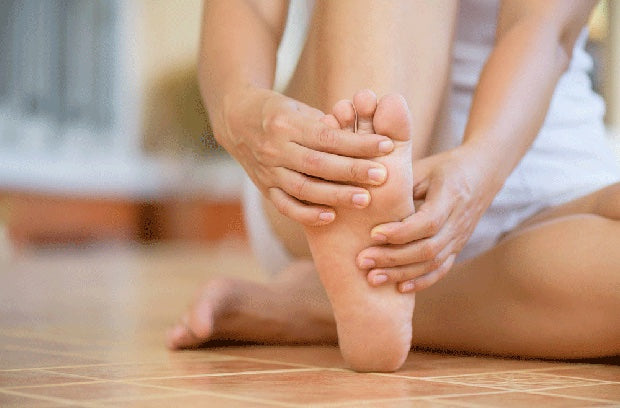Reducing Neuroma Symptoms with Naboso

“It feels like a pebble is in my sock!”
That little pebble sensation in the sock sounds like a simple symptom to treat but for anyone who has ever experienced a neuroma knows that this condition is far from simple!
A neuroma (often referred to as Morton’s neuroma) is a ball of scarred nerve tissue in the bottom of foot, often positioned between the metatarsal heads. Formed by excess pressure and traction on the bones and muscles of the feet, this benign mass of nerve tissue can start to get inflamed and irritated.
Common symptoms of a neuroma include:
- Sensation of a pebble or wrinkle in the sock
- Tingling or numbness between two toes (most commonly 3rd and 4th digits)
- Sharp pain when rolling through the foot or taking a step
Common contributors to neuroma symptoms include:
- Narrow shoes that prevent foot splay and put pressure on the metatarsal heads
- Bunions and wearing shoes that do not accommodate the bunion
- Fascial adhesions and restrictions in intrinsic muscles and fascia
- Unstable foot that is contributing to insufficient fascial tension
Traditional conservative treatment recommendations for a neuroma include injections, orthotics and physical therapy however the success rates may vary greatly. Due to the inconsistent results often experienced by those with neuromas, we at Naboso wanted to share some of our favorite non-traditional ways to relieve neuroma pain.
Splay to Stretch
It should not come to a surprise that we love toe spacers – and that they are great for those with neuroma symptoms.
Consistently using toe spacers such as the Naboso Splay will:
- Stretch small muscles around the digits and forefoot
- Maintain natural digit alignment to minimize any foot compression
- Support forefoot circulation to encourage lymphatic flow around the neuroma
Toe spacers can and ideally should be worn all day in the shoes to support foot splay and forefoot space. To accommodate the toe spacers in shoes, wider and more natural shaped shoes will need to be worn.
Some of our favorite natural shaped shoes include: Xero Shoes, Vivobarefoot, Feel Grounds, Flux and Origo.
Release to Recover
An important part of minimizing neuroma symptoms is to support the natural anti-inflammatory processes in the body which are dependent on circulation and lymphatic flow.
Integrating the Naboso Neuro Ball in a daily foot release will:
- Massage tired foot muscles
- Reduce any stickiness in fascial tissue around the neuroma
- Support circulation around the intrinsics muscles of the feet
Start to using the Neuro Ball domes for our 5 point foot release and make sure to spend some extra time with the powerful RAD Micro hidden inside the Neuro Ball.
This is like a 1-2 punch to foot fascial tightness.
Stimulate to Strengthen
The final step in our neuroma program is to activate and strengthen foot muscles. A big part of how we get neuromas in the first place is delayed foot stability.
Unstable feet, hypermobile feet, and disconnected feet all have a hard time supporting the repetitive stress that occurs around our small toe joints.
Using the Activation Insoles in your shoes will:
- Wake up the small nerves in the bottom of the feet
- Strengthen intrinsic muscles through increased sensory input
- Support proper foot circulation to support tissue healing
The best part of the Activation Insoles is that they can be worn over any existing arch support or orthotic. Simply cut the Activation Insoles to your shoe shape, slide into the shoes and get connected.
***
All of the above are great ways to support neuroma symptoms but please note that everyone has different responses to neuroma treatments. We find that all of the above suggestions work well with other recommendations which may be given to a patient from their medical provider.
To learn more about foot health and sensory stimulation please visit www.naboso.com